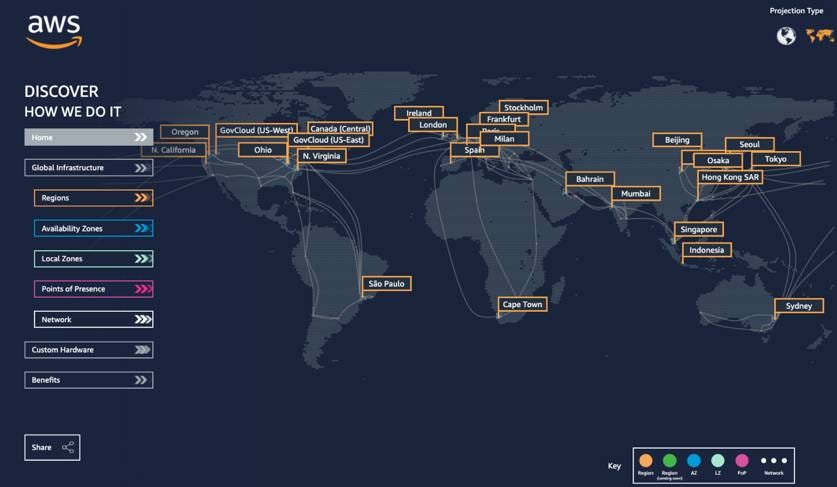This blog is a part of my journey “Embarking on the AWS Solution Architect Associate SAA-CO3 Certification Journey”
Amazon Web Services (AWS), often referred to as the pioneer of cloud computing, has transformed the way businesses operate in the digital age. AWS has a rich history dating back to its early beginnings in 2002 when it served as an internal infrastructure for Amazon.com. Over the years, AWS has evolved into a comprehensive cloud platform, offering a vast array of services to organizations worldwide.
In this blog, we’ll take a trip down memory lane, exploring the key milestones in AWS’s history. We’ll also delve into AWS’s global infrastructure, including Availability Zones, AWS Regions, data centers, and Edge Locations/Points of Presence. Understanding this infrastructure is essential for businesses looking to harness the full potential of AWS’s global reach.
AWS: A Brief History
2002: Inception as Internal Infrastructure
AWS traces its roots back to 2002 when Amazon.com needed a reliable and scalable infrastructure to support its rapidly growing e-commerce platform. The development of AWS began as an internal project to address Amazon’s infrastructure needs.
2003: Emergence as Infrastructure as a Service (IaaS)
In 2003, AWS took its first step toward becoming a public cloud provider by offering Infrastructure as a Service (IaaS). This marked the beginning of AWS’s journey into the cloud computing market, allowing businesses to leverage Amazon’s infrastructure.
2004: SQS Launch
Amazon Simple Queue Service (SQS), a fully managed message queuing service, was launched in 2004. SQS provided developers with a scalable and reliable way to decouple the components of their applications.
2006: Birth of S3 and EC2
One of the most significant milestones in AWS’s history was the launch of Amazon S3 (Simple Storage Service) and Amazon EC2 (Elastic Compute Cloud) in 2006. S3 revolutionized data storage, while EC2 introduced scalable virtual servers, changing the way applications were hosted and scaled.
2007: AWS’s European Debut
AWS expanded its footprint by launching in Europe in 2007. This marked the beginning of AWS’s global presence, allowing European businesses to benefit from cloud services.
2009: Introduction of Virtual Private Cloud (VPC)
In 2009, AWS introduced the Virtual Private Cloud (VPC), enabling users to create isolated network environments within the AWS cloud. VPC brought enhanced security and networking capabilities to AWS users.
For a comprehensive list of AWS services and their launch dates, you can refer to AWS Geek’s AWS History.
AWS Global Infrastructure
AWS’s global infrastructure is a marvel of modern technology. It’s designed to provide high availability, low latency, and scalability to meet the diverse needs of businesses around the world. Here’s an overview of key components of AWS’s global infrastructure:
Availability Zones (AZs)
Availability Zones are isolated data center facilities within an AWS Region. They are physically separate and feature their power, cooling, and networking. AWS customers can deploy resources across multiple Availability Zones to achieve fault tolerance and high availability.
AWS Regions
AWS divides the world into geographic regions, each consisting of multiple Availability Zones. AWS Regions are entirely isolated from one another and are designed to provide redundancy and disaster recovery capabilities. As of my last knowledge update in September 2021, AWS had 24 regions worldwide.
Data Centers
Within each Availability Zone, AWS operates state-of-the-art data centers. These data centers house the servers, storage, and networking equipment that power AWS services. AWS’s data centers are known for their security, reliability, and energy efficiency.
Edge Locations/Points of Presence (PoPs)
Edge Locations, also referred to as Points of Presence (PoPs), are strategically located data centers that serve as the front-end of AWS’s Content Delivery Network (CDN), Amazon CloudFront. These locations cache content closer to end-users, reducing latency and enhancing content delivery speed.
Conclusion
AWS’s journey from an internal infrastructure project to a global cloud computing powerhouse is nothing short of remarkable. Its history is a testament to Amazon’s commitment to innovation and customer-centricity. As AWS continues to expand its global infrastructure, businesses worldwide can harness the power of the cloud to innovate, scale, and thrive in the digital age.
Understanding AWS’s global infrastructure, including Availability Zones, AWS Regions, data centers, and Edge Locations/Points of Presence, is essential for businesses seeking to leverage the full potential of cloud computing. AWS’s global reach ensures that organizations can deliver reliable and responsive services to users around the world, making it a driving force in the digital transformation of industries across the globe.
